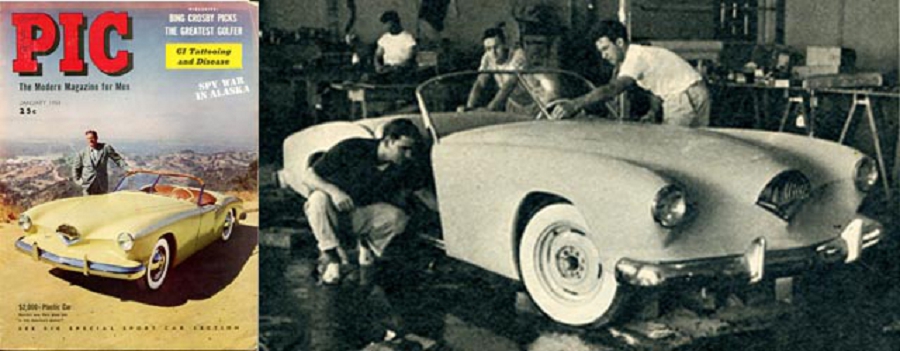
Hi Gang…
Rick D’Louhy and I are trying to paint a picture – a fiberglass picture – of the 1950’s. To do so we’re assembling all known articles big and small. And…. laying on top of the articles is the story of the fiberglass cars from the major manufacturers and independents. The Corvette, the Kaiser Darrin, independent concept cars from designers, and a host of concept cars from the major manufacturers too. No small task here.
By laying down articles, timeframes, and introduction dates of specific production and concept cars, it’s easier to see the influence each car had – or was inspired by – each of the other cars. Think of it as a visual story – and a narrated story we’re trying to tell – 50 years after it happened. It’s a challenge at times.
And that leads us to today’s article.
All Hail Tony St. Clair!
I’m blessed with great friends – Tony St. Clair being one of them. Not only is he an avid fiberglass fanatic having found and now contemplating restoration of a Glasspar G2 and a LaDawri Conquest but…he’s a vintage automobile magazine collector too. A guy after my own heart (sorry ‘bout that Tony).
Time and time again Tony has brought forth a gem of a magazine article – never seen before in the realms of fiberglass sports car collectors across the world. And he’s done it again. About a year ago, Tony shared with me a story published in “PIC” magazine about the Darrin Sports car. It had a great color cover shot of Dutch Darrin and his car, and a nicely detailed story inside as well.
So I pondered the story for awhile. And awhile more. And ruminated on what to do with the story – searching for the best way to introduce it on our website and fit it into the larger story of fiberglass cars of the 1950’s. I discussed the article with good friend Darren Swanson and he filled me in on some of the details about the first Darrin sports car and as I learned more – I asked more questions.
And the answers became more interesting. And so I sought out additional expertise and found Jack Mueller – historian and librarian for the Kaiser Frazer club. Jack was of great help too, and will be adding more detail to our story in a future article.
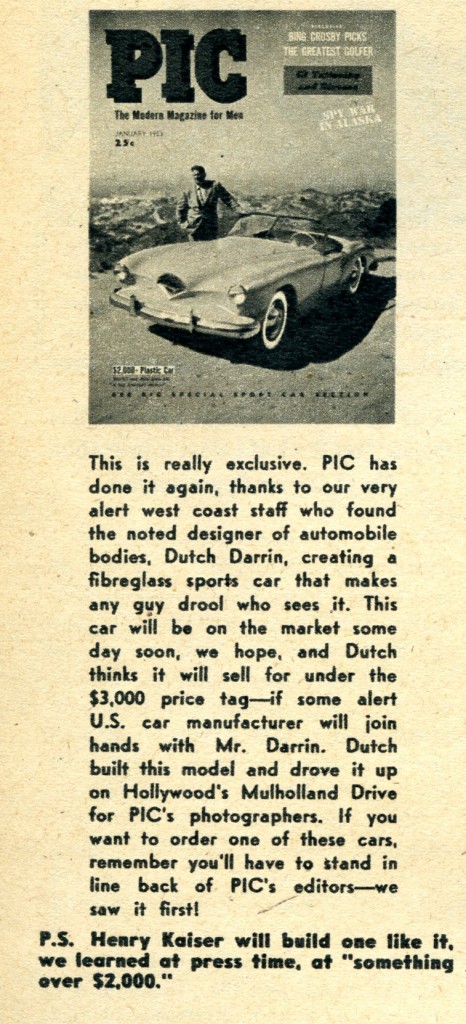 So Why Is This Article Significant?
So Why Is This Article Significant?
What makes this article significant is that it appears to be the first article announcing that the “Darrin Competition” Sports Car is now the official choice of the Kaiser company as their own sports car. Previous to this article, the announcement had been officially publicized in February 1953 in several magazines.
The announcement in PIC Magazine that Tony St. Clair found may push that official announcement date up by one month. Here’s what is said in the inside cover of PIC Magazine:
“P.S. Henry Kaiser will build one like it, we learned at press time, at “something over $2,000.”
Sounds like someone knew something a bit earlier than previous known. In any event, it’s a great article with pictures never seen before, and I’m excited to share it with each of you.
So…let’s turn our attention to the article and see what PIC Magazine had to say about the Darrin Competition Sports Car (on the cusp of being known as the “Kaiser Darrin” sports car). And by the way, you’ll have to read about half-way through this article before you get to the section on Darrin.
And….you’ll read how the author thought “women” were the downfall of sports cars in the 1930’s. Sounds a bit biased to me as I’ve never heard mention of that viewpoint before – but I appreciate all viewpoints and it makes interesting reading.
A couple of interesting points before we dig in:
* First, the article was written before it was known that this was going to be the Kaiser Darrin sports car. That is, Darrin had built this car on “spec” and it was only at the end of 1952 that Kaiser decided to go with this body style as the choice for their sports car. It would be a full year later when the car would become available to the Kaiser Darrin appreciating public.
Only 435 copies would ever be turned out (that’s as much as 50% of all fiberglass bodies produced by Glasspar, Woodill, Victress, Allied, Meteor, Grantham Stardust, and all 1951-1956 fiberglass sports car companies combined).
* Second, in the article, the car was referred to as the “Darrin Competition” sports car. This was its name in 1952 before it became the “Kaiser Darrin.” It was later known as the DKF 161 which I believe stood for “Darrin Kaiser-Frazer” 161 sports car.
Go get ‘em gang!
Designer Darrin And His New U.S. Fiberglass Competition: (PIC Magazine, January 1953)
Is This America’s Answer To The European Sports Car Monopoly?
When Manufactured, It’s Expected To Sell For Under $3,000
By Tom Carlile
Every year since the end of World War II, American automobile manufacturers have looked at the ever-expanding sports car market and then, with a frightened survey of the costs of re-tooling their production lines, have always decided to leave the building of sports machinery in the hands of the Europeans.
But last year, when more than 30,000 Americans plunked down a sizable amount of their hard-earned dollars to buy the racy, low-slung sports cars manufactured abroad, even the slumbering giants of Detroit awoke. Not only is America becoming sports car conscious – it is becoming sports car hungry, and it is about time for the geniuses of mass production to begin producing a sound, low-priced sports car that will fill this demand.
It’s an odd thing about sports cars. America used to build the best in the world….fast, high-powered open-seated jobs that were designed solely for the ability to go. But somewhere back there in the early thirties, American automobiles got bogged down in a welter of chrome, curved windshields and tricky transmissions, and the sports car – the machine you could tinker with, race, and grow to love – died fast.
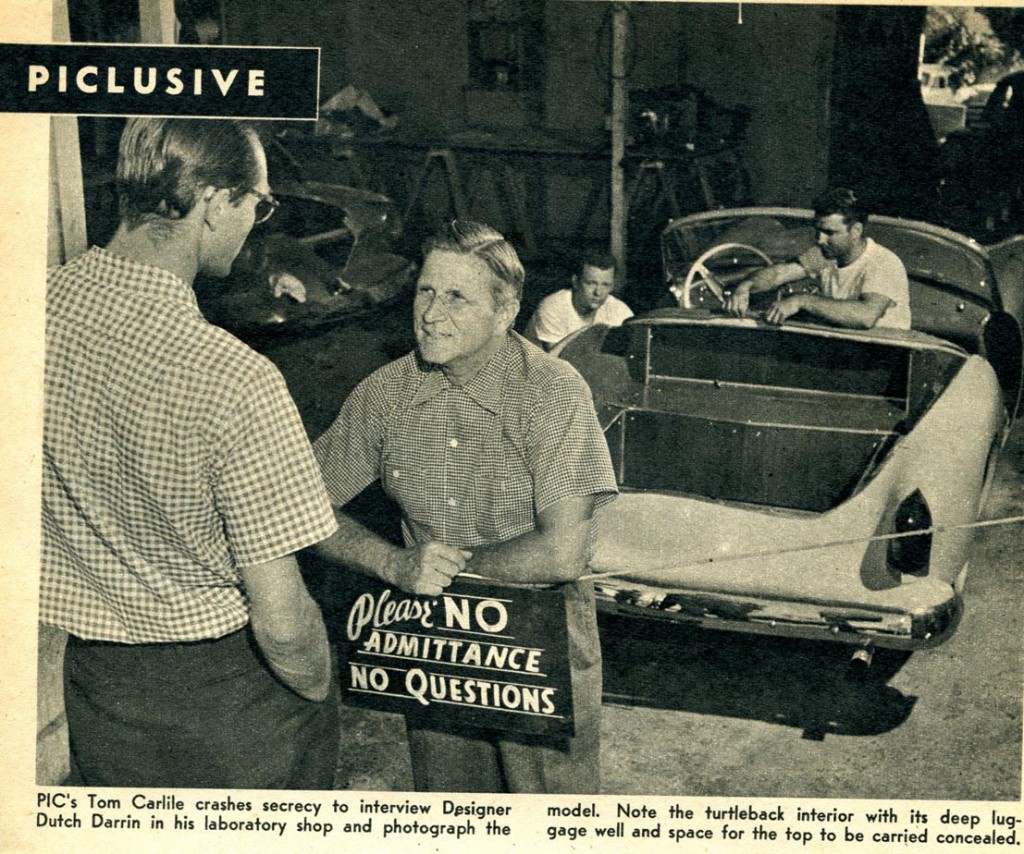
Caption: PIC’s Tom Carlile crashes secrecy to interview designer Dutch Darrin in his laboratory shop and photograph the model. Note the turleback interior with its deep luggage well and space for the top to be carried concealed.
Women fixed it for good. When they began to drive they wanted a big comfortable house on wheels that would roll smoothly and keep the wind out of their curls. They wanted a family car – and so we got the sedan, the big smooth-rolling mush on wheels that typifies the average U.S. automobile today.
Admittedly, it is the best car for the money produced anywhere in the world, but there simply is no way you can disguise it to look or act like a truly racy car. The last true sporting machine manufactured in America was the wonderfully impressive Cord, which expired from lack of sales just about the time ma got behind the wheel. The depression helped bury it, too.
Make no mistake, the sports car has no place on a poverty budget. It is built for speed and for the sheer pleasure of driving, a pleasure which most city dwellers have long since forgotten in the noisy maelstrom of traffic.

Caption: Darrin takes out his latest creation, the most exciting sports car of the year, for a test run. It’s on a standard 100 inch frame.
But today, sports cars are enjoying a fantastic new vogue and they are here to stay. The best known models come from England – the MG’s (of which there are reputedly over 200,000 now operating in the U.S.), the sleek Jaguars, the Allards, the Singers, the Jupiters, and the Aston Martin, to name a few. Italy is the second biggest importer with its famous Ferraris, Siatas, and Cistalias.
In recent months, due to the successes on the race course of the models driven by Roger Barlow and other west coast drivers, the pretty French Simca is enjoying a tremendous popularity. Germany has begun to sell a number of its swift little Porsche, which is an excellent racing machine in the 1500 cc class and a most eye-catching model on the highways.
The U.S. has come up with only two or three sports cars since the end of the war:
- the tiny Crosley, which sells for around $1100
- the powerful and extremely expensive Cunninghams ($9,500 to $11,000)
- and the Nash-Healey, which has both an English body and chassis
But since the tremendous rebirth of interest in sports car racing (90,000 attended the Golden Gate Park event, and over 100,000 watched the Watkins Glen affair), almost all of the big American manufacturers are experimenting with sports models.
Chrysler is reputed to have one in the blueprint stage. Studebaker has a low-slung sports coupe supposedly ready for next year’s market. Buick is planning a sports convertible of sorts for possible early 1953 delivery, but it is hardly the kind of car the true sports fan would buy.
The most exciting new sports car yet to be designed and produced by an American is the Darrin Competition, the sleek fiberglass job shown on the cover of this issue of PIC. Designed by world-famous Custom Designer Howard A. Darrin, this sharp model is the first truly modern sports model to be offered to the American public at a price it can afford, reputedly about $3000.
It will be built on a standard 100 inch frame and will be powered by a 6 cylinder Willys engine which can be supercharged to 115 horsepower. Darrin, who has had more than 10 years of European experience as a custom designer, believes his car will hold its own in competition with any foreign car in the 2.5 liter class and that it will outshine, from a standpoint of tasteful modern design, any sports car on the highway.
Due to some new principles of body design, the Darrin Competition is a deceptively long-looking automobile with an extremely low center of gravity that will make it an easy car to handle at top speeds. The body is just eight inches from the ground.
Most exciting feature of all, however, is the fiberglass construction of the body. Made in three easily molded sections, the body can be manufactured simultaneously in various regions of the country. Many manufacturers have experimented with fiberglass construction, but Darrin has been one of its foremost and earliest sponsors.
In 1954, for instance, he built the first all-plastic body – a sleek sports sedan which he planned to put into production but which was junked when the quality of the material then proved unsatisfactory. Since then, Darrin has experimented with Fiberglas until he evolved his present body style, the Darrin Competition.
Fiberglass is a very practical body material. It can be polished to an extremely high luster, and is in many ways superior to steel as a body material. It has a greater tensile strength than steel, and can be repaired for only a fraction of the cost of replacing metal sections.
Darrin began working on the model of his sports car early this year (1952) although he has had the idea of building a low-priced sports car since the end of the war. He has worked for six months on the construction of the first model, which is a sincere attempt at creating a sports car which will truly meet the American’s need for a small, fast second car.
It will be no patchwork imitation of European models, but an individual and modern bucket that any sports enthusiast will be thrilled to drive and own. It will be speedy and maneuverable, with the kind of open visibility that gives an added sense of speed to the driver in his low-pitched bucket seat.
From his own wide experience as a custom designer, “Dutch”, as Darrin is known throughout the auto industry, is convinced that his car will be in the vanguard of American sports cars that are sure to come along soon, now that there is a ready and growing market for them in the U.S. He realizes that we cannot expect to compete overnight with European sports machinery.
The European cars that we are now seeing were originally built for road racing or for fast, quick-accelerated performance on the tricky European roads. America meanwhile has been concentrating almost entirely on luxury and economy. But once Detroit gets into the sports car picture, it is sure to overshadow the Europeans in producing a swift, low-priced sports car with innovations of design far ahead of the rather static European models.
Most European cars are built in small shops with limited production facilities and trained personnel; they are, in almost a true sense of the word, custom cars. They could never be produced in quantity, and already the demand for many models is a year ahead of production.
Of course, the real test of any sports car is its performance in road race competition, and before any American manufacturer can hope to sell his product to the real enthusiasts, it will have to win its share of races and perform near the top of its class. Right at the moment, there is no American car that has done so, with the exception of the Cunningham, which is truly a custom racing car.
Darrin’s trim little car has that trial ahead of it, and beauty of design won’t be enough in that test.
Let’s Focus on Some Timeframes:
So let’s explore this a bit more and focus on the timing of this announcement. First, some points to consider:
* 1946: Darrin builds first fiberglass / plastic bodied sports car
* Fall 1952: Darrin completes his second fiberglass sports car known as the Darrin Competition Sports Car
* November 1952: Petersen Motorama: Darrin introduces his sports car at the Motorama in the hopes of getting Kaiser interested in producing the car.
* November 1952: Petersen Motorama: Woody Woodill quickly introduces the Series 1 Woodill Wildfire in the Petersen Motorama in hopes of wooing Willys – an independent car manufacturer – as choosing his car for their sports car.
* February 2nd, 1953: Time Magazine: Woodill Wildfire is shown and announcement made that it will by stocked by Willys dealers starting in April 1953
* March 2nd, 1953: Time Magazine: Gerry E. Lyons, Vice President Sales of Willys-Overland Motors publishes confirmation of the fact that Willys-Overland Motors has made no arrangements with Woody Woodill to stock his cars at any Willys dealerships. Lyons goes on to say that “Willys-Overland is in no way the car’s sponsor.”
* March 27th, 1953: Motor World Magazine: The following announcement is made: “Negotiations aimed at merger of Kaiser-Frazer and Willys Overland were in the news this week.
* June 1953, Road and Track: The following announcement is made: “Purchase of Willys Overland by a Kaiser-Frazer subsidiary is not subject only to approval of Willys stockholders.”
So…Darrin’s gamble that his sports car – designed on a Henry J (Kaiser) chassis – would be successful came true, and in January 1953 the “Darrin Competition Sports Car” became the “Kaiser Darrin Sports Car – DKF 161.” Production would begin within a year on the Kaiser Darrin fiberglass sports car. Woodill’s gamble was on target too, but didn’t fare as well.
When Lyons shut down the rumors of the new Willys sports car in the March 2nd1953 issue of Time Magazine, it was about 3 weeks later that the merger between Kaiser and Willys began to be publicized. And…if Kaiser and Willys were to be one company – they needed just one sports car at most – not two sports cars so the fate of the Woodill Wildfire was sealed, and Woody quickly began making plans to create this as a kit car which would debut in August 1953 to a very excited public.
Summary:
Thanks again to Tony St. Clair for his terrific skills at producing long-lost magazine articles about fantastic fiberglass cars. Greatly appreciated Tony!
Also, Darren Swanson and I have been talking about this article in detail. In the next story about the Kaiser Darrin, I’ll share more photos and some of Darren’s thoughts about this significance of this first Darrin Competition Sports Car too.
Hope you enjoyed the story, and until next time…
Glass on gang…
Geoff
——————————————————————-
Click on the Images Below to View Larger Pictures
——————————————————————-
- Caption: PIC’s Tom Carlile crashes secrecy to interview designer Dutch Darrin in his laboratory shop and photograph the model. Note the turleback interior with its deep luggage well and space for the top to be carried concealed.
- Caption: Darrin takes out is latest creation, the most exciting sports car of the year, for a test run. It’s on a standard 100 inch frame.
- Caption: Top view accents its sleek design. Further road tests must be met before manufacturing.
- Caption: Assembling under way, but you can’t peek at its innards just yet.
- Caption: Fiberglas bodies can easily be made anywhere in the U.S. (Dutch Darrin Shown in Picture).
- Caption: Starter button installed on simple instrument board.
- Caption: Dutch Darrin and his son, Bob, who assists in their work, check blueprints.
- Caption: Engine is placed far forward with storage space for spare tire provided.
- Caption: Setting braces for the seats. Note the unusual design of the turtleback.
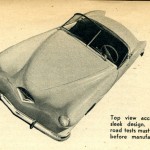
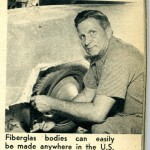
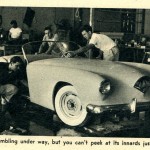
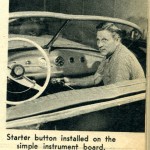
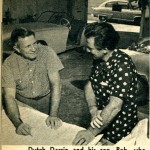
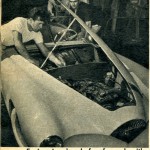
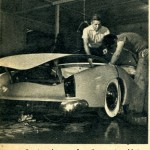
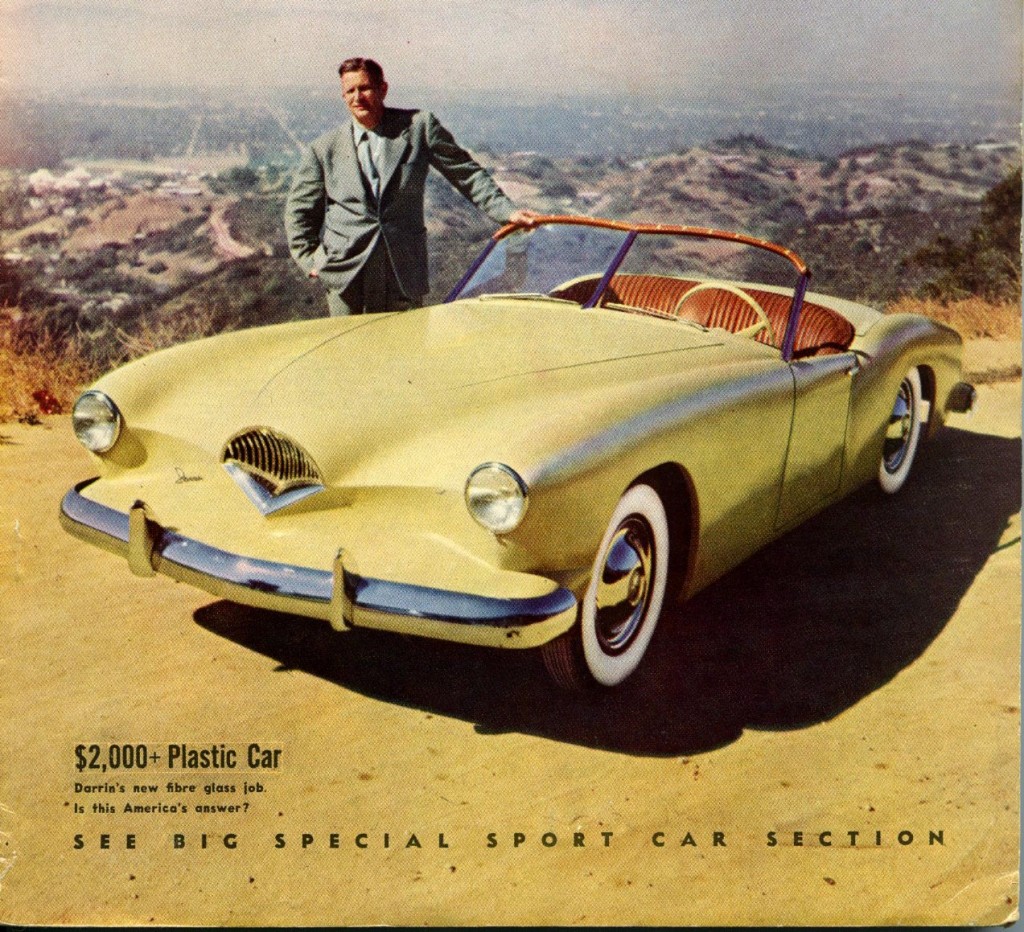










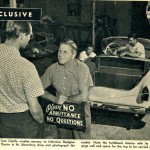
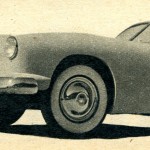
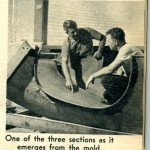
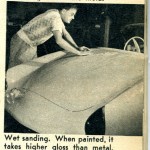
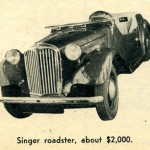


This site is protected by reCAPTCHA and the Google Privacy Policy and Terms of Service apply.